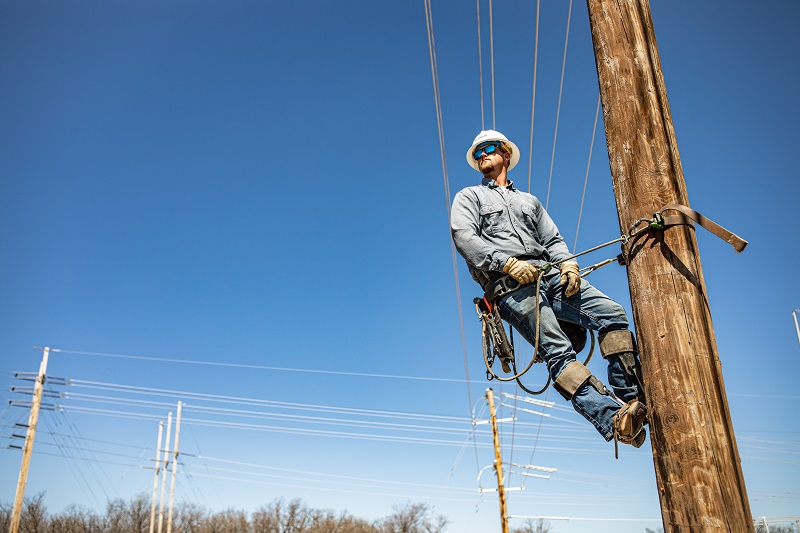Missouri's Overhead Power Line Safety Act
Did you know it’s illegal for any unauthorized person to work or bring equipment within 10 feet of high-voltage overhead power lines that have not been covered or de-energized?
At Liberty, our highest priority is a commitment to safety – not only for our employees, but for our customers and our community. With that commitment in mind, we’re sharing the full text of Missouri’s Overhead Power Line Safety Act, which regulates work performed in close proximity to overhead lines. It requires you to make special arrangements with Liberty should you need to work within 10 feet in any direction of our lines, so that we can de-energize and ground it or take other precautions to ensure that you stay safe.
If you have any questions, please contact us at 1-800-206-2300.

The complete text of the Overhead Power Line Safety Act, effective August 28, 1991:
319.075. Citation of law. — Sections 319.075 to 319.090 may be cited and shall be known as the “Overhead Power Line Safety Act.”

319.078. Definitions. — As used in sections 319.075 to 319.090, the following terms mean:
(1) “Authorized person”:
(a) An employee of a public utility or an employee of a contractor which has been authorized by a public utility to perform construction, operation or maintenance on or near the poles or structures of such utility;
(b) An employee of a cable television or communication services company or an employee of a contractor authorized to make cable television or communication service attachments; or
(c) An employee of the state or a county or municipality which has authorized circuit construction, operation or maintenance on or near the poles or structures of a public utility;
(2) “High voltage”, electric potential in excess of six hundred volts measured between conductors or between a conductor and the ground;
(3) “Overhead lines”, all electrical conductors installed above ground;
(4) “Person”, an individual, firm, joint venture, partnership, corporation, association, municipality, or governmental unit which performs or contracts to perform any function or activity upon any land, building, highway or other premises in proximity to an overhead line;
(5) “Public utility” includes those entities defined as such in section 386.020 as well as municipally owned electrical systems and electric cooperatives provided for in chapters 91 and 394.

319.080. Activities within ten feet of power lines prohibited, exceptions. — Unless danger against contact with high voltage overhead lines has been guarded against as provided by section 319.083, no person, individually or through an agent or employee, shall store, operate, erect, maintain, move or transport any tools, machinery, equipment, supplies or materials or any other device that conducts electricity, within ten feet of any high voltage overhead line, or perform or require any other person to perform any function or activity upon any land, building, highway or other premises, if at any time during the performance thereof it could reasonably be expected that the person performing the function or activity could move or be placed within ten feet of any high voltage overhead line.

319.083. Special devices and precautions required — costs. — 1. When any person desires to temporarily carry out any function or activity in closer proximity to any high voltage overhead line than is permitted by sections 319.075 to 319.090, the person or persons responsible for the function or activity shall notify the public utility which owns or operates the high voltage overhead line of the function or activity, and shall make appropriate arrangements with the public utility for temporary mechanical barriers, temporary de-energization and grounding of the conductors, temporary rerouting of electric current or temporary relocating of the conductors, before proceeding with any function or activity which would impair the clearances required by sections 319.075 to 319.090.
2. A person requesting a public utility to provide temporary clearances or other safety precautions shall be responsible for payment of those costs incurred by such utility in the temporary rerouting of electric current or the temporary relocating of the conductors. Upon request, a public utility shall provide a written cost estimate for the work needed to provide temporary clearances or other safety precautions. A public utility is not required to provide such clearances or other safety precautions until payment of the estimated amount has been made. Unless otherwise agreed to, a public utility shall commence work on such clearances or other safety precautions within seven working days after payment has been made.

319.085. Presumption of negligence, when, rebuttable. — If a violation of any of the provisions of sections 319.075 to 319.090 results in physical or electrical contact with any high voltage overhead line such violation shall be a rebuttable presumption of negligence on the part of the violator in the event such violation shall cause injury, loss or damage, and, notwithstanding any other law to the contrary, the public utility shall have the right of contribution against any such violator. In addition to any penalties provided herein, liability under common law may apply.

319.088. Exemptions from law. — Sections 319.075 to 319.090 shall not apply to:
(1) Construction, operation or maintenance of power lines and telecommunications lines or authorized attachments thereto by an authorized person as defined in section 319.078; or
(2) Governmental entities responding to an emergency situation.

319.090. Violations, penalty. — Any person who violates any of the provisions of sections 319.075 to 319.088 is guilty of a class B misdemeanor.
Click the link below to return to the Electrical Safety page.
